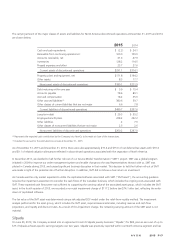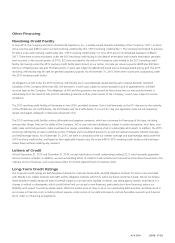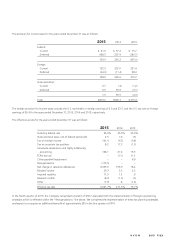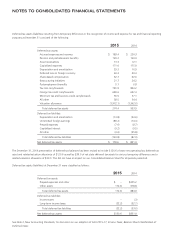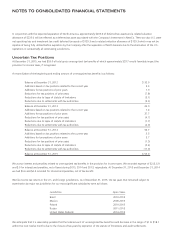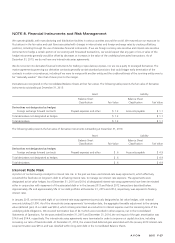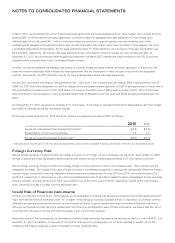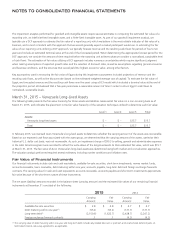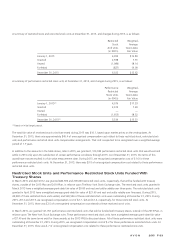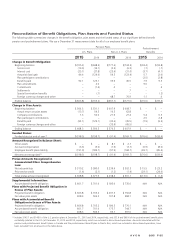Avon 2015 Annual Report Download - page 107
Download and view the complete annual report
Please find page 107 of the 2015 Avon annual report below. You can navigate through the pages in the report by either clicking on the pages listed below, or by using the keyword search tool below to find specific information within the annual report.At December 31, 2015, we had recognized deferred tax assets of $746.1 relating to U.S. business credit carryforwards (excess foreign tax
credits, minimum tax credits, research and experimentation credits and investment tax credits) for which a valuation allowance of $746.1 has
been provided, deferred tax assets relating to foreign tax loss carryforwards of $656.9, for which a valuation allowance of $651.7 has been
provided and deferred tax assets relating to state tax loss carryforwards of $125.0 for which a valuation allowance of $125.0 has been
provided. The foreign tax loss carryforwards as of December 31, 2015 were $2,302.1, of which $2,134.6 are not subject to expiration and
$167.5 are subject to expiration between 2016 and 2030. The state tax loss carryforwards as of December 31, 2015 were $1,750.0 which
are subject to expiration between 2016 and 2035. The U.S. foreign tax credit carryforwards of $689.6 are subject to expiration between
2018 and 2025; the U.S. minimum tax credits of $35.9 are not subject to expiration; the U.S. research and experimentation credits of $16.3
are subject to expiration between 2027 and 2035 and the U.S. investment tax credits of $4.3 are subject to expiration between 2020 and
2030.
At December 31, 2015, we continue to assert that our foreign earnings are not indefinitely reinvested, as a result of our domestic liquidity
profile. Accordingly, we adjusted our deferred tax liability to account for the balance of our undistributed earnings of foreign subsidiaries
and for the tax effect of earnings that were actually repatriated to the U.S. during the year. We also adjusted our deferred tax liability to
exclude deferred tax assets of $94.9 associated with our foreign earnings that we do not plan to repatriate within the foreseeable future.
The deferred tax liability associated with the Company’s undistributed earnings increased by $74.9, resulting in a deferred tax liability
balance of $89.2 related to the incremental tax cost on $1.4 billion of undistributed foreign earnings at December 31, 2015. This deferred
income tax liability amount is net of the estimated foreign tax credits that would be generated upon the repatriation of such earnings. The
repatriation of foreign earnings may result in the utilization of a portion of our excess foreign tax credit carryforwards in the year of
repatriation; therefore the utilization of our foreign tax credit carryforwards is dependent on the amount and timing of repatriations, as well
as the jurisdictions involved. We have not included the undistributed earnings of our subsidiary in Venezuela in the calculation of this
deferred tax liability as local regulations restrict cash distributions denominated in U.S. dollars.
At December 31, 2015, the valuation allowance primarily represents amounts for all U.S. deferred tax assets, certain foreign tax loss
carryforwards and certain other foreign deferred tax assets. The recognition of deferred tax assets was based on the evaluation of current
and estimated future profitability of the operations, reversal of deferred tax liabilities and the likelihood of utilizing tax credit and/or loss
carryforwards. Tax planning strategies were also considered and evaluated as support for the realization of deferred tax assets. Where these
sources of income existed along with sufficient positive evidence that indicated it was more likely than not that such sources of income could
be relied upon, then the deferred tax assets were not reduced by a valuation allowance.
The net increase in the valuation allowance during 2015 of $609.5 was primarily due to the recording of the valuation allowances for U.S.
deferred tax assets (discussed further below), partially offset by the increase in the deferred tax liability for unremitted earnings of foreign
subsidiaries discussed above. In addition, the net increase in the valuation allowance was also attributable to additional valuation allowances
for deferred tax assets outside of the U.S., primarily in Russia, which was largely due to lower earnings and the impact of foreign exchange
losses on working capital balances.
During the first and second quarters of 2015, the Company recorded a $31.3 charge and a $3.2 benefit, respectively, associated with
valuation allowances, to adjust our U.S. deferred tax assets to an amount that was “more likely than not” to be realized. These adjustments
were primarily caused by fluctuations of the U.S. dollar against currencies of some of our key markets.
During the third quarter of 2015, we recorded an additional valuation allowance on our remaining U.S. deferred tax assets of $649.5. The
increase in the valuation allowance resulted from management’s determination that it was no longer more likely than not to realize the tax
benefits expected to be obtained from tax planning strategies associated with an anticipated accelerated receipt in the U.S. of foreign source
income. As the U.S. dollar had further strengthened against currencies of some of our key markets during the third quarter of 2015, the
benefits associated with the Company’s tax planning strategies were no longer sufficient for the Company to continue to conclude that its
tax planning strategies were prudent. In the absence of any alternative prudent tax planning strategies and other sources of future taxable
income, it was determined that a full valuation allowance should be recorded. Although the Company continues to expect that it will
generate taxable income and tax liability in the U.S., the Company is expected to offset its current and future tax liability with foreign tax
credits, and as a result, the expected level of future taxable income and tax liability is not adequate to realize the benefit of previously
recorded deferred tax assets. Although the Company may not be able to recognize a financial statement benefit associated with its deferred
tax assets, the Company will continue to manage and plan for the utilization of its deferred tax assets to avoid the expiration of deferred tax
assets that have limited lives.
A V O N 2015 F-25
7553_fin.pdf 97




